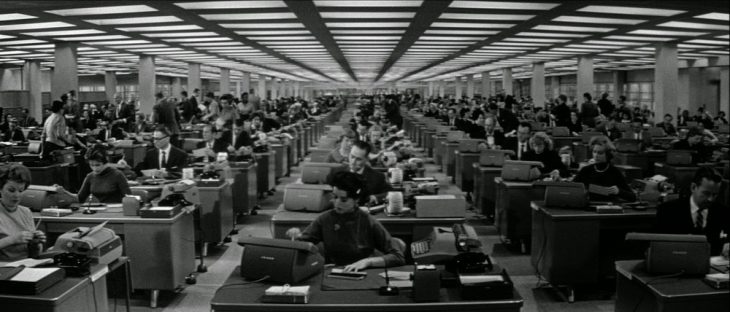The NeoCon 2019 proposals offered an incredible array of topics from all sectors of the industry. Here are a few of the seminars that caught our eye. Check out part one here.
This year there was a wealth of options for The Mart’s Program Advisory panel to review and select. The diversity of offerings was not only in subject matter but also in the number of new presenters that came forward to speak to the issues that the NeoCon 2019 range of attendees would appreciate.
For the first time, a selection of seminars is available on Sunday, June 9th for those that arrive in Chicago early, and like to pick up their credentials ahead of the Monday morning rush. Check out those Neocon 2019 seminars here.
Of key interest to our newly minted designers will be the new seminar presented by Thom Banks, CEO of the Council for Interior Design Qualification (CIDQ) located in Alexandria, VA, and Jim Klawiter, CIDQ board president, based in Los Angeles, California who filled us in on what CIDQ has been doing to benefit the design profession.

Alphabet Soup: The Importance of Earning Your NCIDQ Certification
Sunday, June 9 11:00 AM – 12:00 PM
WDM: Early in my career, I was encouraged to go for the exam as professional credentials not only validate your expertise but strengthen the profession. How do you see obtaining certification as one of the critical elements as a career-making building block?
TB/JK: Achieving NCIDQ certification differentiates practitioners that can demonstrate a specific set of core competencies, supported by verified work experience and a college degree. No other Interior Design credential assesses health, safety, and welfare knowledge and it’s a requirement to become professionally licensed/certified/registered in every regulated jurisdiction in the US or Canada except for California. Nearly all significant firms require NCIDQ certification for promotion to senior positions and allied professionals (with their certification exams) recognize and respect the effort and commitment achieving it requires. Lastly, IIDA’s just released compensation study reported that that interior designers with an NCIDQ certification command a median salary $12,600 higher than those without certification. Whether interior designers pursue NICDQ certification for the reasons cited above or are simply motivated to pursue it as a measure of personal achievement, NCIDQ certification has become the industry-recognized “gold standard” for demonstrating professionalism.
WDM: In some jurisdictions, there is a movement to de-regulate professional licensure – (hello Florida) – Where do see that considering this development- that it is even more important for the professional community to maintain and develop credentialing and certification criteria?
TB/JK: The Deregulation movement in the United States, which is targeting so many different professions, is typically couched in terms of “economic freedom” and removing barriers to occupational entry. While those issues are important, CIDQ believes the anti-regulatory movement oversimplifies the issues and overlooks the reason professional regulation exists in the first place…to protect the health, safety, and welfare of the public.
CIDQ supports policies and legislation that enable interior designers to practice to the full extent of their capabilities by administering a rigorous, objective exam that assesses the professional competency of interior designers to practice in a manner that protects public health, safety, and welfare.
Periodic regulatory review is healthy, and CIDQ has mechanisms in place to help address many of the concerns raised (licensure portability, streamlining of jurisdictional licensure processes) by those seeking regulatory reform. However, CIDQ believes the interior design profession continues to be unfairly targeted and, in some instances, deliberately misrepresented by opposition forces.
Interior Designers need to be legally recognized as design professionals in the same manner as the practitioners of the related disciplines with whom they work. A fair, valid, reliable and legally defensible exam which assesses their ability to practice in a way that safeguards the public remains the best justification and underpinning for that recognition.

WDM: How has moving to a computerized exam benefited the exam process?
TB/JK: CIDQ transitioned the last of its three exam sections (the Practicum) to a computerized format in October of 2017. We saw this transition as critical to our continued growth and success in the marketplace. With the old Practicum, we were shipping paper all over the US and Canada, shipping it back, then sending it out to be graded, and back again, etc. There were so many opportunities for things to go wrong…boxes don’t arrive when or where they should, issues with ad-hoc test locations all around the US and Canada, exam security concerns, etc. However, ultimately, the biggest reason for the change was that we needed to be in alignment with the testing expectations of new generations of test takers. The fact that (under the old exam) you could only take this eight-hour, hand-drawn, exam on one of two weekends a year made it hard for people to access it. With the computerized exam, we were able to introduce a new method of measuring the same competencies in less time in a more objective way that was more accessible to all. Now, candidates can take all three sections of the exam anytime during the months of April and October throughout the U.S. and Canada, and sometimes, around the world!
You can find out more about the CIDQ test development process here.

How many times a day do you see an article or image of a new coworking space? Yes, we know it is the most active space in workplace design. We connected with Matt Gammel, Practice Area Lead, Jacobs, Los Angeles, CA.
Coworking: Novelty or Innovation?
Monday, June 10 9:30 AM – 10:30 AM
WDM: Coworking has been a real disruptor. What are a few of the positive ways you think this trend has informed current workplace planning and design?
MG: Coworking has evolved from various changes within work cultures and technology advancements. We now can work almost anywhere besides our office spaces to accomplish daily tasks. Another critical reason working remotely has become the norm rather than the exception is due to the entrepreneurial nature of the millennials (and others). It’s created a thriving economy comprised of freelancers and startups that required shorter and more flexible lease terms. Leasing providers understood this style of working was more than a trend and threw out traditional office space design, and truly listened for what the occupiers of the spaces wanted: agility, scalability, hip factor, and community. We see the term “space as service” pop up frequently in conversations with landlords, including coworking providers. Taking a page from the coworking playbook, we see positive and ubiquitous effects on planning and design. As personal space shrinks, communal and dual- or multi‐purpose spaces now encourage spontaneity, teamwork, and extended learning while creating more efficient and higher performing workplaces.
Coworking spaces can offer shorter return-on-investment cycles for landlords. They can get the benefit a larger single tenant with a longer lease, rather than managing several smaller tenants with varying lease lengths. Coworking spaces are occupying 100 percent of some office buildings as the sole tenant.
WDM: Conversely what do you think are the negative aspects that are problematical for designers and strategists?
One core area of concern is the disruption of the traditional design and delivery process. Coworking companies that now provide various services, such as leasing, design, construction, facilities and operations functions challenge the status quo. This isn’t a bad thing since it’s positioning industries to up their game to remain competitive. However, there is some uncertainty about how each affected industry will shake out.
A negative consequence is the adoption of the coworking “look” without consideration of “feel,” meaning acoustics, change management from traditional to more open work environments, and the physical relationships between focused and open work settings. It’s a disturbing trend that could result in a commoditized design for some organizations. Open office spaces are a hot topic, and many negative opinions are based on unsophisticated planning and real estate strategies.
WDM: We are now seeing a shift in players, there are the large players, the small local niche providers, and now landlords and the larger brokerages are getting into the game. Any predictions about how you think this will all shake out?
MG: Coworking spaces have started to become the largest single tenants in many gateway cities, and it’s clear the market has adjusted to this non-traditional workplace design and tool for occupancy strategy. The media has brought attention to the fact that many coworking ventures have yet to turn a profit. This trend could go a few ways. It’s begun to entice landlords, larger brokerages and local/niche coworking providers to throw their hat in the ring, believing their expertise/location may yield profitability in this arena. In some cases, we’re beginning to see landlords and coworking providers co-invest in building out coworking space, effectively sharing risk (and rewards). Conversely, this might frighten some investors due to the risk and unknowns.
It’s too soon to determine how this will all shake out. I’d like to refer to a quote from Mark Corbett, founder of the technology venture capital firm, Pace Ventures:
“If the term coworking ever disappears from common use, it will only be because it becomes synonymous with our notion of (office) working.”




Iron Age Office has the most amazing furniture pieces I have ever seen.
[…] the industry. Here are a few of the seminars that caught our eye. Check out part one here and part two […]
[…] industry. Here are a few of the seminars that caught our eye. Check out part one here; part two here; and part three […]